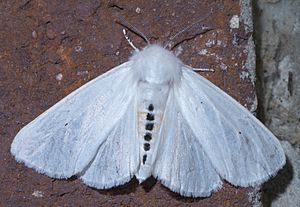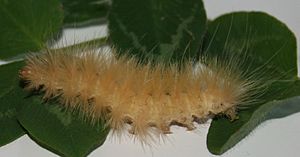Spilosoma virginica facts for kids
Quick facts for kids Spilosoma virginica |
|
|---|---|
 |
|
 |
|
| adult (top) larva (bottom) | |
| Scientific classification |
The Spilosoma virginica is a type of moth that has two common names depending on its life stage. When it's a caterpillar, people often call it the yellow woolly bear or yellow bear caterpillar. But once it grows up into an adult moth, it's known as the Virginian tiger moth.
Contents
The Yellow Woolly Bear Caterpillar
What They Look Like
The yellow woolly bear caterpillar can be different colors. However, each caterpillar usually has one main color of hair. You won't see strange patches of different colored hair or a head that is a different color from its body.
What They Eat
These caterpillars enjoy eating many kinds of low-growing plants. This includes plants like grass and clover that grow close to the ground. When they eat, they are called "defoliators" because they chew holes in leaves, making them look like skeletons. Usually, only the caterpillars born in late summer are numerous enough to cause much harm to farm crops. This moth usually goes through two or three full life cycles each year. In colder places, one group of caterpillars will sleep through the winter.
The Virginian Tiger Moth (Adult)
The adult moth often rests with its wings folded like a tent over its back. It is mostly white, but its body has a darker color. It does not have the clear, dark eyes that its close relative, the agreeable tiger moth, has. This moth is not poisonous. However, some people might have a small allergic reaction if they touch the tiny bristles on its body.
Reproduction
When they are caterpillars, the female is a bit bigger than the male. As an adult moth, the female finds a mate by releasing a special scent called a pheromone. The male moth can smell this pheromone. Unlike the female, the male has large, feathery antennae that help him find the scent. He flies in a zigzag pattern until he finds the female. After they mate, the male flies off to find other females. The female then lays between 20 and 100 eggs. She places them in a single layer on the underside of a leaf. When the larvae (young caterpillars) first hatch, they stay together. But as they grow bigger, they start to live on their own.

